Editor’s note: Seeking Alpha is proud to welcome The Beginner Investor as a new contributor. It’s easy to become a Seeking Alpha contributor and earn money for your best investment ideas. Active contributors also get free access to SA Premium. Click here to find out more »
Thesis
Banco Bilbao Vizcaya Argentaria S.A. (NYSE:BBVA) is a globally diversified bank, meaning it will experience minimal impact from the Spanish Bank Tax payment implemented since February 2023. This tax only applies to the net income generated within Spain, not across other countries where BBVA operates. Consequently, smaller banks that primarily concentrate on the Spanish market will likely bear the brunt of the tax burden. For BBVA, the impact is expected to be around 3.5% of its net income.
Furthermore, BBVA is well-positioned to sustain its 6% dividend yield and has the potential to increase it while achieving stable, albeit not extraordinary stock price growth. I would set the stock target at EUR8.16 ($8.73 as of the current exchange rate of EUR1/$1.07) for the near term.
BBVA’s dividend per share since 2015 (Author’s calculation)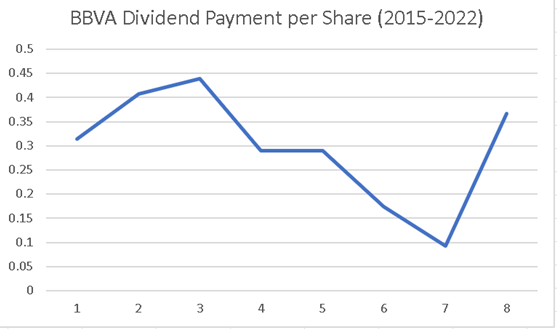
Company Overview
Recent History
After the financial crisis of 2008, Spanish banks, including BBVA, were severely impacted due to their irresponsible banking practices intertwined with government corruption. However, BBVA devised a plan in the aftermath of the crisis to pivot towards digitalized banking, focusing on sales driven by digital platforms. This transformation plan reached its pinnacle in 2017, positioning the bank strongly to capitalize on potential opportunities, which materialized with the recent interest rate hikes.
BBVA’s Market
BBVA primarily operates in Latin America, Spain, and Turkey, where the banking landscape is less competitive compared to the United States. For instance, in Mexico, there are approximately 50 banks, while in the U.S., the number exceeds 4,000. This factor itself confers an advantage to BBVA, as it can leverage its substantial size and reputable status as a reliable and modern bank with roots dating back to 1857. Based on my experience, I can affirm that Latin Americans tend to remain loyal to their banks for extended periods, unless they have a very bad experience. Furthermore, due to the limited options available, clients are less likely to switch banks. To summarize, in Latin American markets, customer loyalty is strong, and the scarcity of competitors shields larger banks like BBVA from significant client attrition, even during situations such as interest rate increases when clients may seek higher-yielding deposits.
Financials
As previously said, BBVA has acknowledged the importance of enhancing its operational efficiency, and to that end, it has embraced a strategic shift towards digital banking, as outlined in its 2017 Transformation Plan. The results thus far have been impressive, with notable growth in digital sales across its key markets. This efficiency drive is particularly evident in the remarkable expansion of both net operating income and gross income, with a notable surge observed post-2019 (period 3 in the second graph below). It is worth highlighting that the growth in net operating income has outpaced the increase in gross income during this period.
Net Operating Income and Gross Income (Author’s Calculation) Net Operating Income and Gross Income Growth Rate (Author’s Calculation)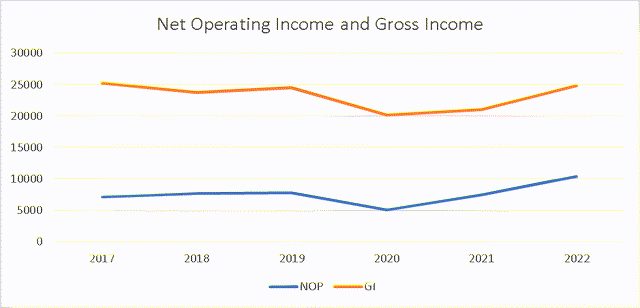
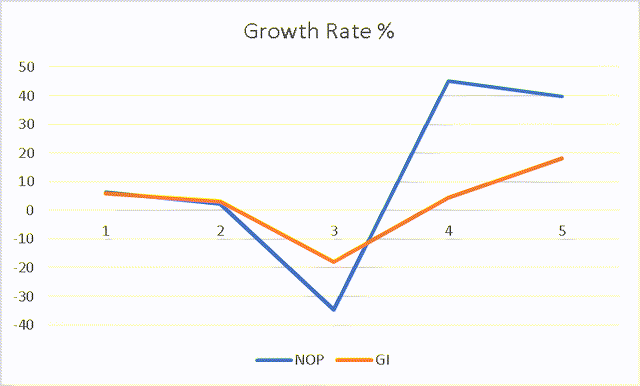
The improvement in efficiency has resulted in three significant outcomes: a substantial cash reserve, which has experienced an annualized growth rate of 7% since 2018, currently totaling EUR80 billion ($85.6 billion); an improving Free Cash Flow to Equity, which surged during the rate hikes; and BBVA’s ability to capitalize on the rate hikes.
BBVA Cash position (Author’s Calculation)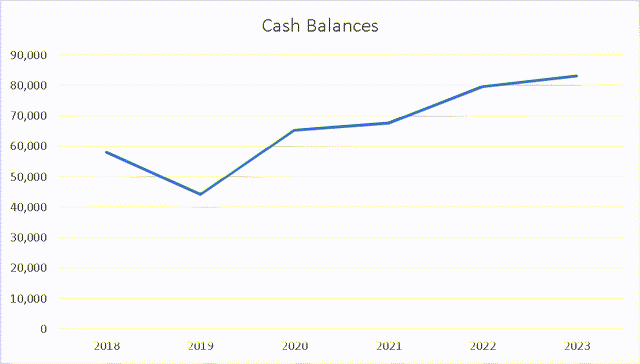
FCFE (Author’s calculation)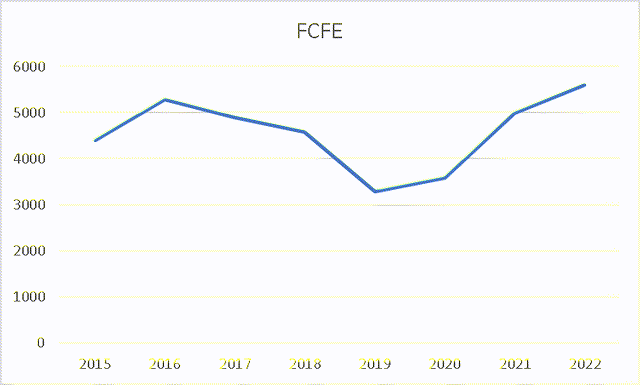
These three variables are pivotal in defining the bank’s dividend-paying capacity, and as I have already emphasized, they have increased over the years since 2008. The third variable is exemplified in the accompanying graph, demonstrating the correlation between interest rates and Net Interest Income. Notably, BBVA consistently and promptly responds favorably to rate hikes. I have also included my forecast for Q2 2023, projecting a noteworthy surge of 5% to reach EUR5,924 ($6,338) compared to the previous figure of EUR5,642 ($6,036) in Q1. It is worth mentioning that historical data indicates that for every 0.75 rate hike, BBVA’s net interest income typically experiences an increase ranging from 4% to 5%.
Net interest Income in relation to Rate Hikes (Author’s Calculation)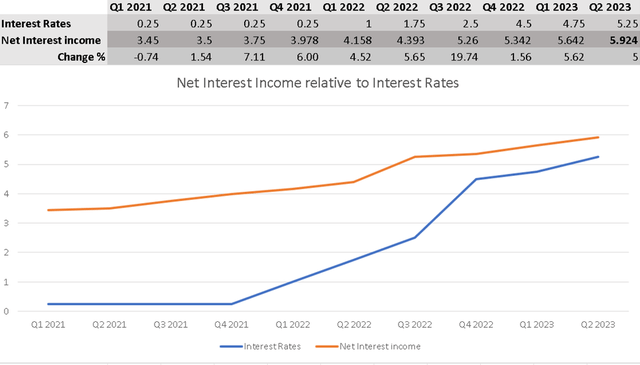
Valuation
For this stock, I will pursue a relative valuation approach since, as it is well known, DCF may not work well with financial stocks. Additionally, there are too many variables to consider for DDM at the moment, such as whether BBVA will decide to reduce its dividend to invest in the business and drive stock price growth instead of dividend, or implement a stock buyback program.
The first aspect that indicates BBVA is undervalued is its P/E ratio in comparison to its peers. To make a fair comparison, I have selected other banks with similar exposure to developing economies: Banco Santander S.A. (SAN), HSBC Holdings plc (HSBC), Bank of America Corp. (BAC), BNP Paribas S.A. (OTCQX:BNPQY), and Citigroup inc. (C). HSBC, Santander, and Citigroup have business models closest to BBVA in this region, all of them being exposed to retail banking. Citigroup, for instance, operates through Citibanamex in Mexico. These banks all have a significant presence in the region, with numerous branches and ATMs. BNP Paribas and BofA primarily focus on investment banking in this region, but I included them because BBVA also offers investment banking and private banking, and I wanted to take into account that aspect of their business.
In the table below, you can observe that these banks have similar P/E ratios, except for BofA, which has a P/E of 8.99. The average P/E I calculated is 6.75, while BBVA’s current P/E stands at 6.20. Although the difference may not seem significant, it would imply a share price of EUR7.22 ($7.72), representing a 13% increase from the current stock price of EUR6.34 ($6.78). I have mentioned that BBVA’s EPS for the past 12 months is 1.07, comprising Q1 2023, Q4 2022, Q3 2022, and Q2 2022.
P/E ratio (Author’s Calculation)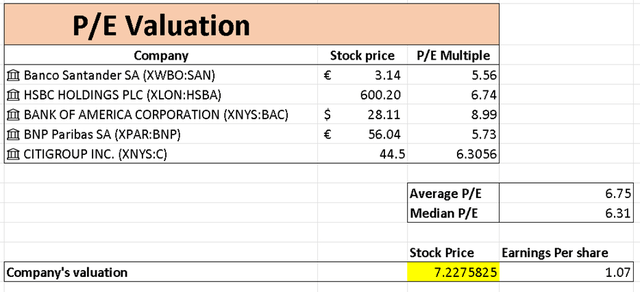
However, the metric that strongly suggests BBVA is undervalued is its tangible book value, which has remained stable since 2016. In the graph below, the main point is that BBVA’s market cap is below its tangible book value, indicating a potential opportunity for profit. If BBVA’s market cap adjusts to its tangible book value of EUR49.262 billion ($52.710 billion), it would correspond to a stock price of EUR8.16 ($8.73), representing a potential upside of up to 24%.
Market Cap (Orange) Tangible Book Value (Blue) Starts from 2014 (Author’s Calculation)
Then when examining the Price to Tangible Book Value ratios of these banks, it becomes evident that BBVA, despite offering one of the highest dividend yields (6.64%), is trading at the same levels as Santander and HSBC, which offer dividend yields of 4% and 3%, respectively. Among these banks, BNP Paribas boasts the highest yield at 6.96%, and its P/TBV ratio of 1.12 is significantly better than BBVA’s 0.75. The superior ratios of BNP, BofA, and Citigroup may be attributed to their better growth prospects and dividends (in the case of BNP), while BBVA is unfairly penalized due to the uncertainty surrounding whether its impressive growth over the past three years is a result of its transformation plan or high interest rates.
P/TBV (Author’s Calculation)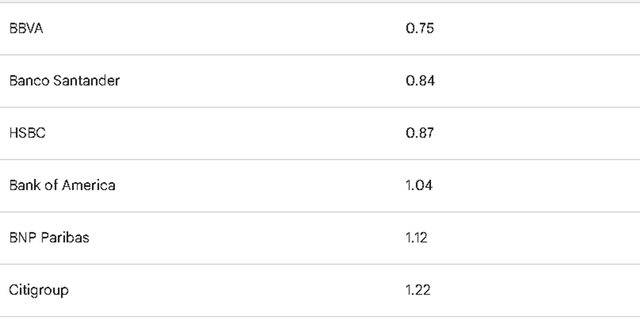
I believe that these metrics provide compelling evidence to evaluate whether BBVA is undervalued. The Market Cap to Tangible Book ratio unmistakably demonstrates that BBVA is indeed undervalued. Regarding the sustainability of BBVA’s dividend, the answer is undoubtedly affirmative, at least for the upcoming year. However, considering the possibility of future decreases in interest rates, I anticipate a reduction in the dividend yield to a range of 3%-4% beyond that timeframe. Despite this adjustment, the yield would still remain highly favorable, instilling confidence in investors regarding BBVA’s financial strength to consistently deliver returns on its stock price. This confidence is bolstered by BBVA’s substantial cash reserves and strong balance sheet. With these factors in mind, I have established a stock price target of EUR8.16 ($8.73), meaning it would return to 2013 levels. It is important to note that even with the projected reduction in dividend yield, BBVA would be able to retain ample funds from this high interest rates period to support its long-term growth.
Risks
In order for the aforementioned target to be fulfilled, it is crucial to have positive market sentiment, such as during a rally. Although the stock may be undervalued, its true value will only be realized if investors are willing to purchase the stock and overcome their fear stemming from the recent banking crisis (I want to emphasize that BBVA is in no way at risk of collapsing in the near term).
BBVA does not face immediate risks because, as mentioned earlier, it is in a strong financial position, trades below its tangible book value, and has successfully executed its transformation plan. However, even though BBVA does not currently face immediate risks within its business model, its stock can face challenges in the event of a recession or if market sentiment remains weak. In such cases, it may take some time for BBVA to reach the target I have set. However, the only way I will abandon my bullish position is if the fundamentals of BBVA deteriorate significantly.
Conclusion
I anticipate that BBVA would be able to maintain its dividend. Looking ahead, it is likely to offer a dividend yield of 4%-5% considering that interest rates will not remain high indefinitely and the bank’s improved efficiency following its 2017 transformation plan. I support this statement by analyzing BBVA’s growing cash balance and the enhanced Free Cash Flow to Equity (‘FCFE’) observed in 2021 after the interest rate hikes. Taking into account the bank’s response to rate increases, I predict that the first one will likely be EUR5,924 ($6,338) for Q2 2023.
For the near term, I have set a target of EUR8.16 ($8.73). This target will likely be realized if BBVA’s market cap adjusts to its Tangible Book Value.
The primary risk to this thesis is the possibility of a recession, particularly one more severe than a “mild” downturn, which would inevitably impact the developing markets in which BBVA operates, such as Latin America and Turkey.
Overall, I maintain a positive outlook on the bank’s ability to generate returns and sustain its dividend, even in the event of future interest rate reductions. This is because, in my opinion, BBVA has already proven that it does not solely rely on interest rate hikes to enhance its profitability.
Read the full article here


